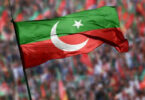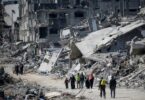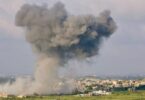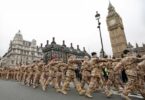Richard Gowan
Prior to this week’s NATO summit in Brussels, Poland stirred up discussions of sending an international peacekeeping force to Ukraine. The concept, which Polish officials have emphasised is at a “preliminary” stage, is to deploy a force that could assist with humanitarian operations and would be robust enough to defend itself in combat. The proposal is unlikely to gain traction since, like the idea of a NATO-enforced no-fly zone over Ukraine, it raises the risks of direct confrontation with Russia. But peacekeeping operations come in many shapes and sizes, and it is possible that some sort of international presence will eventually be needed to support a cessation of hostilities in Ukraine. Policymakers should not let speculation about unrealistic peacekeeping options distract them from the immediate priority, which is to facilitate a negotiated settlement to the war. But it is still useful to think about what role some kind of peace operation – which is more likely to involve peace observers than fully fledged combat troops – could play if such a settlement does become feasible.
A Chilly Reception for Poland’s Proposal
While the war continues unabated, there is little chance of a successful international deployment to mitigate the conflict. The Organization for Security and Co-operation in Europe (OSCE), which previously oversaw a civilian monitoring mission in Ukraine, withdrew its international personnel in February and early March. Prior the Polish gambit, some commentators had suggested that UN peacekeepers deploy to protect Ukraine’s nuclear plants, but Russia insisted there was no need for UN involvement.
The Polish proposal for a “peace mission” under NATO or “some wider international structure” followed a visit by the Polish, Slovenian and Czech prime ministers to Kyiv to show solidarity with Ukraine on 15 March. Poland’s influential Deputy Prime Minister Jarosław Kaczyński, who joined the trip, championed the peacekeeping idea upon his return. Details of the proposed operation have been rather scant, although a government spokesman in Warsaw did specify that it should deploy only in those parts of Ukraine that are not under Russian control. U.S. advocates of the idea, such as Jim Jeffrey, a former envoy for Syria, have suggested that NATO should focus on securing safe havens in the west of Ukraine.
While some NATO members, such as Denmark, expressed interest in the proposal, a number of key players in the alliance responded unenthusiastically. U.S. Ambassador Linda Thomas-Greenfield underlined that the U.S. would not participate. Czech Defence Minister Jana Černochová also poured cold water on the idea, suggesting that a UN blue helmet mission would be preferable. Hungary has explicitly threatened to block the proposal.
The reasons for this chilly response are clear. Russia attempted to justify its assault on Ukraine by claiming that NATO had plans to absorb the country, and Ukrainian Prime Minister Volodymyr Zelenskyy has conceded that Kyiv may need to accept permanent neutrality. Putin also warned that outside actors who intervened in the conflict would face “consequences greater than any [they] have faced” in history. The deployment of a NATO-flagged mission – or an independent multinational force largely made up of troops from NATO members – would look like a deliberate challenge to Moscow. The Kremlin has admonished that such an operation would be “very reckless and extremely dangerous”.
But while the Polish initiative will almost certainly fizzle, there is a case for thinking through how peace operations at the lighter end of the spectrum – such as civilian or military monitoring teams to support a ceasefire – could be useful in Ukraine in the future.
What Peacekeepers Can Do
Peace operations exist on a spectrum ranging from civilian peace observation to very robust peace enforcement operations, such as those NATO deployed to Kosovo and Afghanistan. As NATO troops discovered in the Afghan case – and NATO forces in Ukraine would probably discover at even greater cost – the line between robust peace maintenance and war fighting can be dangerously blurry. As for “lighter” missions – ie, ones that are less reliant on military force to reach their goals – it is important to be clear-eyed about what they can achieve. Unarmed or lightly armed observers can facilitate the implementation of a ceasefire and political agreement, if both sides want such deals to succeed, or flag warning signs that one side or another is deliberately breaking its commitments. Of course, Russia and Ukraine are not near this point yet, but it is possible to consider a scenario in which Kyiv and Moscow strike some sort of tentative bargain and need help to make it stick.
There have been on-and-off discussions of peacekeeping in Ukraine since the initial crises over Crimea and Donbas eight years ago.
There have been on-and-off discussions of peacekeeping in Ukraine since the initial crises over Crimea and Donbas eight years ago, although today’s war has rendered most previous proposals irrelevant. The OSCE launched its Special Monitoring Mission (SMM) in Ukraine in 2014, during the initial turmoil over Russia’s occupation of Crimea. The SMM was an unarmed civilian mission, involving 1,400 international and local staff at its peak, that gained a solid reputation for impartial reporting on the fighting. It also succeeded in negotiating local truces to allow authorities to undertake tasks such as repairing water supply infrastructure.
But Ukrainian officials and their allies also sought to gauge interest in proposals for a more robust international presence. Former Ukrainian President Petro Poroshenko floated the idea of a UN force in Donbas in 2015. There was a brief moment of excitement in Kyiv and Western capitals in 2017, when Russian President Vladimir Putin indicated that he might also be open to a UN mission in Ukraine, although Russian diplomats in New York followed up with only a thin proposal for lightly armed UN guards to accompany SMM monitors. The Trump administration pursued talks with Russia on options for a UN deployment in 2018, and a number of conflict resolution organisations, including Crisis Group, developed proposals for what such a mission might look like in 2017 and 2018. Some were distinctly ambitious, envisaging forces of 20,000 or more troops and police – under UN command or at least with a UN mandate – in Donbas to oversee reintegration of the self-declared Donetsk and Luhansk People’s Republics into Ukraine.
In retrospect, all this effort was worthy but probably futile. As Crisis Group noted in December 2017, U.S. and Russian officials were able to discuss the tenets of peacekeeping but “U.S. diplomats admit that it is easier to agree on principles with Russia than concrete measures”. Moscow’s real level of interest was never clear. And while it was easy to sketch plans for forces of 20,000 troops on paper, some of the nations the U.S. hoped would supply peacekeepers, such as Sweden and Finland, were distinctly queasy at the prospect of their personnel facing off against recalcitrant Russian forces. The whole idea gradually went away.
Changed Assumptions
Whatever value these earlier discussions of peacekeeping had at the time, many of the assumptions involved no longer hold. The starting points for most previous proposals for peace operations in Ukraine included the ideas that 1) Russia would support a deployment, in return for incentives such as sanctions relief, meaning that peacekeepers would at least in theory face only few potential spoilers; and 2) the operation would be confined to Donbas (Crimea was generally seen as off the table). On the basis of these notions, it seemed fair to assume that it would be possible to manage missions directly or indirectly via the UN Security Council. Most analysts accepted NATO could not be directly involved.
The starting points for thinking about any peace operation in Ukraine are now very different. Russia’s war has spread far beyond Donbas, meaning that – depending on the course of the war and the circumstances when major hostilities cease – the area of operations for a peacekeeping mission might be far more extensive than previously envisioned. It is also hard to imagine, at least right now, achieving the level of cooperation between Russia and outside actors that would allow a mission to succeed. Officials in a number of Western capitals say that they have done some preliminary thinking about what a peacekeeping mission in Ukraine might look like, but caution that it is too early to do detailed planning for concrete operations. Veteran peacekeepers underline that all peace operations need to either serve an existing political settlement or (at a minimum) create space for the conflict parties to work out the terms of such a settlement. The deployment of international forces in situations where there is neither a real political process nor a settlement to support – as in the former Yugoslavia in the 1990s – is normally a recipe for mission creep or mission failure, or both.
There is no sign of when a cessation of hostilities will be possible in Ukraine, and what it will involve. Scenarios range from a situation in which Russia ceases hostilities holding onto large areas of Ukrainian territory indefinitely, to one in which Moscow agrees to relinquish the land that it has seized since late February. Moscow and Kyiv have also floated ideas – from the former proposing “demilitarisation” of Ukraine to the latter contemplating permanent members of the Security Council offering the country security guarantees – that could affect what international military or civilian peacekeeping mechanisms might eventually be feasible.
Contingency Planning
While any serious planning efforts will have to wait, it is possible to do some basic contingency planning for what a peacekeeping operation in Ukraine might look like. This planning should focus on what will likely be the initial element of any deal: the monitoring, verification and facilitation of the halt to hostilities and ensuing disengagement of forces. (Complicating matters, conflict resolution experts distinguish between different types of arrangement for ending hostilities, ranging from brief truces to formal, long-term ceasefires, all the way to detailed political settlements. Formal ceasefires and peace agreements usually involve more robust verification mechanisms than temporary pauses in combat.)
Should it be possible for Ukraine to strike a bargain to end the war with Russia, Kyiv will likely want reassurance that Moscow will fulfil the ceasefire terms. The Ukrainians will have good reason to worry about the credibility of any ceasefire. Russia could agree to a pause in combat solely to buy time to resupply and rotate its forces, prior to a renewal of hostilities. There is also a danger that, as after any period of intense fighting, individual units could attack their foes after a formal ceasefire. Or accidental clashes could escalate. An international presence could monitor and respond to such incidents, rather as UN, OSCE and European Union observers have variously monitored the front lines in places such as southern Lebanon and Georgia.
If the war was to halt with the battle lines as they stand, it would be exceptionally difficult for any external actor to establish and sustain a large-scale mission along all fronts.
Such monitoring does not necessarily demand the deployment of large forces, but rather lightweight observation teams. If the war was to halt with the battle lines as they stand, it would be exceptionally difficult for any external actor to establish and sustain a large-scale mission along all fronts. The UN has, for example, roughly 1,000 blue-helmeted troops patrolling the Golan Heights between Israel and Syria. They cover a disputed border that is around 65km in length, north to south. By contrast, the “southern front” alone in the current Russian-Ukrainian war – running from Kherson to Mariupol – is over 400km long. A Golan-type operation in Ukraine would be untenable. Any observation mission would need to be able to cover large areas lightly, deploy teams to investigate security incidents quickly, and pass messages between the Russian and Ukrainian field commanders. There are lessons to draw from the pre-war activities of the SMM, which used drones to watch areas its monitors could not, and the UN has experimented with similar technologies elsewhere in recent years.
Who could pull together such a lightweight, flexible observation mission at short notice? One option, as Crisis Group has noted, is to hold the old SMM on standby. OSCE members need to agree on the mission’s future mandate before March ends, but one option is to put it into formal “hibernation” – preserving it as a legal entity even as its operations remain paused – to allow for its rapid reactivation. It is, however, possible that Ukraine, Russia or both will want military as well as civilian monitors to oversee a ceasefire. Foreign military officers have the operational advantage of thinking and speaking in similar terms to the soldiers they monitor – although former military personnel often take jobs in civilian missions, too – and come with the political blessing of their home countries. The OSCE does not specialise in even limited military missions. In contrast, the UN could, in technical terms, take on this role, as it has run military observation missions since the late 1940s.
While often dismissed as slow-moving, the UN has proven able to start up lightweight missions quite rapidly in other crises. In 2012, for example, the UN was able to get 300 military observers and over 100 civilian staff to deploy across Syria in six weeks (although this episode became a cautionary tale about deploying a peace operation in unfavourable circumstances, as a spike in violence meant that they would be withdrawn almost as fast). With a sense of urgency, the UN should be able to manage a similarly rapid deployment across Ukraine. But political problems could easily kick in. A major one would be to identify military officers from states that both Moscow and Kyiv would trust. While Ukraine might like to see NATO nationals, Russia could argue that only personnel from non-aligned countries, or from post-Soviet states, should deploy. Potential candidates could be the Latin American states, which have a long history of peacekeeping, or perhaps the United Arab Emirates, which sent troops to help NATO in Afghanistan but has worked to maintain good ties with Russia during the current crisis. But even politically neutral UN member states might recoil from putting their personnel in harm’s way.
Given the inevitable political headaches of working through multilateral bodies such as the OSCE and UN, a third option would be for Russia and Ukraine to dispense with these organisations. International legal expert Marc Weller has suggested that Moscow and Kyiv sign a peace agreement mandating a “mixed commission” of Russian and Ukrainian officers chaired by a mutually acceptable third-country representative to oversee ceasefire and disengagement issues. An arrangement of this type would not only sidestep multilateral nuisances, but also require a very small number of foreign military personnel.
It is too early to say which, if any, of these ideas will prove of value if and when a cessation of hostilities is possible in Ukraine. In the interim, national and international officials in concerned countries can take certain prudential steps to prepare for the possibility of peace observation in Ukraine – including the “hibernation” of the SMM and quiet planning in UN headquarters for military observation. Defence staffs in countries that might contribute to any mission should prepare rosters of military personnel and civilian experts with Russian and Ukrainian language skills and/or previous tours of duty with UN observation missions.
The international response to the war in Ukraine and its eventual aftermath will extend far beyond observation or peacekeeping. The UN and other agencies are already involved in risky humanitarian missions. If peace is possible, post-conflict reconstruction will require immense investments by the EU, international financial institutions and other actors. Peacekeeping may prove to be a small part of this mix of international efforts or no part of it all. There is a natural tendency in moments of crisis to raise the idea of “peacekeeping” in a vague way, much as Poland has done. In the case of Ukraine, it would be unwise to invest too much hope in the prospects for peace operations. But it would be smart for those who might be called upon to launch a mission to begin getting their options in good order now.
Courtesy: (Crisisgroup)






